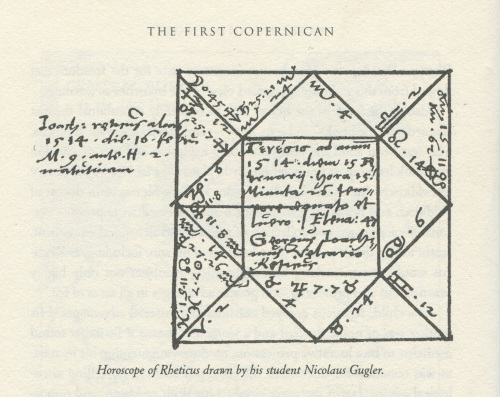Georg Joachim Rheticus was born 500 years ago today in Feldkirch, now in Austria, on 16th February 1514, as Dennis Danielson put it in the title of his excellent Rheticus biography, he was the first Copernican. [1] It was Rheticus who travelled to Frauenburg in 1539 and over many months persuaded Copernicus to publish his De revolutionibus, publishing his own Narratio prima, to test the water for the heliocentric hypothesis in 1540.
Rheticus’ name will always be associated with that of Copernicus and heliocentrism. Another who is inseparably bound up with Copernicus and heliocentrism is Galileo Galilei who celebrated his 450th birthday yesterday, or did he? All over the Internet people were celebrating Galileo’s 450th birthday yesterday, the 15th February, Both the MacTutor History of Mathematics article and the English Wikipedia give his birthdate as 15th February 1564, the latter citing Galileo at Work by Stillman Drake, the Grand Seignior of Galileo studies, but was it? Already on Thursday last week as people were gearing up for the great day Lorenzo Smerillo of Montclair State University pointed out on the History of Astronomy Mailing List that Galileo was actually born on the 16th February and not the 15th. Somewhat confused, I turned to the two most recent scholarly biographies of Galileo, David Wootton’s Galileo Watcher of the Skies[2] and John Heilbron’s Galileo[3]; the former says the 15th, the latter the 16th. Interestingly both refer to Galileo’s horoscope, which he cast himself. Another Galileo expert William Shea gives the birthdate in his Galileo Selected Writings, as the 16th and in a footnote explains the reason for the confusion, the same one that Smerillo had already given and which I will now explain.
As you can see Galileo’s horoscope gives the date and time of birth twice:
1564. 15. febr. h. 22.30. lat. 42. 30
16. febr. h. 4. pm
3.30
The first set of figures are given in Italian hours, which follow the Islamic and Jewish custom of numbering the hours of the day from sunset. Sunset on the 15th February in Northern Italy was at 5:30 pm so the 22.30 hour on the 15th would be 4 pm on the 16th. This is of course the second set of figures giving the date and time of birth in French hours. This shows clearly that Galileo was born on the 16th not the 15th. The 3.30 is probably an error estimate based on uncertainty as to the time of sunset.
Confusingly Wootton argues against this interpretation insisting on the 15th in a complex discussion of the subject.[4]
Our double anniversary is however somewhat confused by another piece of calendrical confusion. Both of our heliocentric astronomers were born before the calendar reform so their birthdates are given according to the Julian Calendar, this of course means that our double anniversary is not actually today but first on the 26th February.
Just to throw another spanner into the works, both of the birthdates are taken from Renaissance horoscopes making them instantly suspect, why? It was a common practice in the Renaissance for astrologers to rectify horoscopes. This was the practice of adjusting times of birth by hours and even sometimes a whole day to make the resulting horoscope more harmonious with the real life of the horoscope’s subject. Rheticus for example was known to be an adherent of this practice.
[1] Dennis Danielson, The First Copernican, Georg Joachim Rheticus and the Rise of the Copernican Revolution, Walker and co., New York, 2006
[2] David Wootton, Galileo Watcher of the Skies, Yale University Press, New Haven and London, 2010
[3] J. L. Heilbron, Galileo, Oxford University Press, Oxford, 2010
[4] David Wootton, Accuracy and Galileo: A Case Study in Quantification and the Scientific Revolution, The Journal of the Historical Society, Vol.10, 2010 pp. 43-55



Pingback: Allgemeines Live-Blog ab dem 14. Februar 2014 | Skyweek Zwei Punkt Null
You forgot to mention how Galileo only cast his own horoscope for the scudi…
Knowing Galileo I’m sure he would have loved to have found a way to get paid for casting his own horoscope.
Is there a good description somewhere of how to read those horoscope-square thingys? Maybe with some description of their history. I always wonder what exactly they mean.
Monica Azzolini, whose “The Duke and the Stars” I’m reading at the moment (review to appear here soon), recommends C.J. Eade, The Forgotten Sky: A Guide to Astrology in English Literature, Oxford, Clarendon Press for explanations of the nuts and bolts of astrology. It appears however to be out of print but is available in good university libraries.
To get you started the twelve triangles around the perimeter are the horoscope and represent the houses. The triangle middle left is the first house and the line between it and the triangle above is the Ascedant. The various symbols are the planets plus lunar nodes and the zodiac signs with the figure giving the positions of the planets within the signs and the houses. Got that!
Pingback: ScienceSeeker Editors’ Selections: February 16-February 22, 2014 | ScienceSeeker Blog